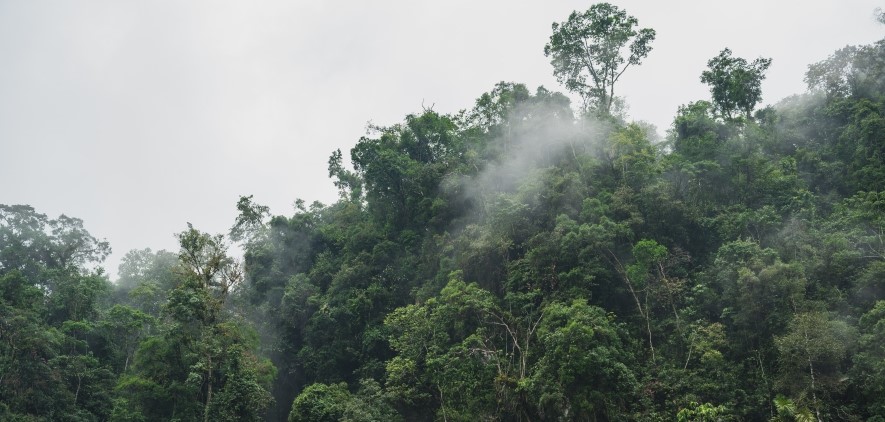Rainforest photo by Conscious Design / Unsplash

Submitted by Rachel Gardner on Mon, 30/10/2023 - 14:47
Researchers have invented a more reliable and transparent method than previously of estimating the benefit of carbon stored as a result of forest conservation.
Developed using tools including computer modelling, this new approach to valuing the carbon storage potential of natural habitats aims to help restore faith in offset schemes by enabling investors to directly compare carbon credit pricing across a wide range of projects.
The method has just been published in the journal Nature Climate Change. In their paper, the researchers – including two in this Department – argue that saving tropical forests is not only vital for biodiversity, but also a much less expensive way of balancing emissions than most of the current carbon capture and storage technologies.
Their new approach works a bit like a lease agreement: carbon credits are issued to tropical forest projects that store carbon for a predicted amount of time. The valuation is front-loaded, because more trees protected now means less carbon released to the atmosphere straight away.
The technique involves deliberately pessimistic predictions of when stored carbon might be released, so that the number of credits issued is conservative. But because forests can now be monitored by remote sensing, if projects do better than predicted – which they usually will – they can be rewarded through the issue of further credits.
The payments encourage local people to protect forests: the carbon finance they receive can help provide alternative livelihoods that don't involve cutting down trees.
Nature-based solutions are undervalued right now because the market doesn't know how to account for the fact that forests aren't a permanent carbon storage solution. Our method takes away a lot of the uncertainty.
Prof Anil Madhavapeddy
"Carbon finance is a way for us – the carbon emitters of the richer world – to direct funds towards rural communities in the tropics so they can get more out of the land they have, without cutting down more trees," says Andrew Balmford, Professor of Conservation Science at the University of Cambridge and first author of the paper.
"But nature-based carbon solutions are highly undervalued right now because the market doesn't know how to account for the fact that forests aren't a permanent carbon storage solution," adds Anil Madhavapeddy, Professor of Planetary Computing here and Director of the Cambridge Centre for Carbon Credits, who was involved in the study. "Our method takes away a lot of the uncertainties."
The new method, developed by scientists at the Universities of Cambridge and Exeter and the London School of Economics, is called 'Permanent Additional Carbon Tonne' (PACT) accounting, and can be used to value a wide range of nature-based solutions.
 And this is important as conversion of tropical forest to agricultural land results in vast carbon emissions. Around 30% of all progress towards the ambitious net-zero commitments made at COP26 is reliant on better management of carbon in nature.
And this is important as conversion of tropical forest to agricultural land results in vast carbon emissions. Around 30% of all progress towards the ambitious net-zero commitments made at COP26 is reliant on better management of carbon in nature.
Developing the new method has proved tricky, as Anil Madhavapeddy explains, and has involved using huge amounts of forest measurement data collected via satellites to help calculate the baseline levels of carbon stored in forests.
It has also involved complicated future modelling. "The technique we propose in the paper depends on the calculation of the future 'release schedule' for an intervention project, and that requires some complex modelling to get right.
"We can't be entirely naive in our estimate (for example, assuming that a woodland will go from undisturbed to concrete overnight) as that would be unrealistically conservative and would economically penalise the owners.
"On the other hand," he adds, "if we are too optimistic in our estimates of how long a forest will remain undisturbed into the future, then we will over-credit the owners and overestimate the climate benefit of an action.
"Solving this modelling problem is right down the purvey of computer science: we are currently using a blend of game theory, queueing theory and other techniques from computer systems modelling to build models of 'tropical forest release schedules' that hit the sweet spot of being conservative and realistic.
"This in turn makes maximises the amount of money that can be channelled to tropical forest conservation projects."
And that is the hope. As another of the paper's co-authors Srinivasan Keshav, Robert Sansom Professor of Computer Science here, adds: "Our new approach has the potential to address market concerns around nature-based solutions to carbon offsetting, and lead to desperately needed investment."
- This story is taken from a longer article first published on the University of Cambridge website Read the full story here.

